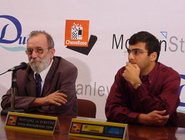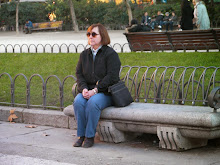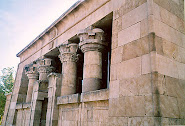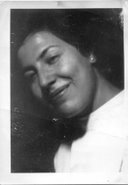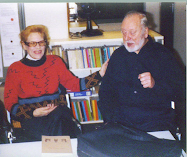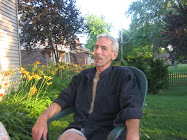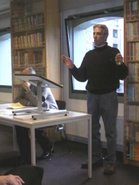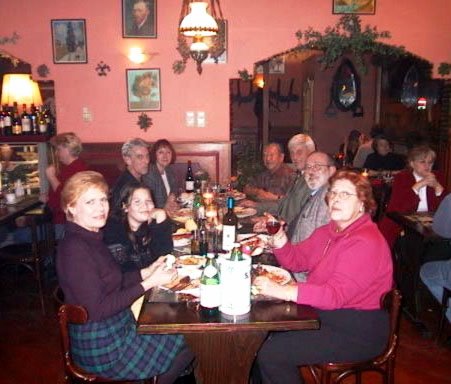Saturday, October 3, 2009
Ancient Hawaiians in New Zealand?
Want Wealth and Good Fortune? Pray to Laxmi
Friday, October 2, 2009
Chanca/Wari Ruins Found in Peru
Hondurans Turn to Virgin Statue for a Miracle
 Article from The Wall Street Journal online
October 2, 2009
At 3 Inches Tall, La Morenita Casts a Big Shadow in Honduran Crisis
When All Else Fails, Nation Turns To the Virgin of Suyapa for a Miracle
By NICHOLAS CASEY
SUYAPA, Honduras -- In the past three months, a slew of Latin American presidents, foreign ministers, ambassadors and even a Nobel Peace Prize winner, have failed to find a solution to the political standoff that has split Honduras. Now, many despairing Hondurans say, may be time for a little divine intervention.
So every day, more and more Hondurans are calling on the Virgin of Suyapa, a 3-inch statuette of the Virgin Mary, made of dark wood and nicknamed La Morenita, or the Little Dark One, for help. Over the centuries, La Morenita, which was found on a hillside in 1747 and now makes its home at a small whitewashed colonial church near the capital, has been credited with sundry miracles, from curing kidney stones to ending a brief war.
"I've asked her to intervene," said Abad Zelaya, 42 years old, a pharmacist and no relation to ousted President Manuel Zelaya, who has been holed up in the Brazilian embassy for more than a week since he sneaked back into Tegucigalpa. Mr. Zelaya's ouster three months ago has led many countries, including the U.S., to suspend aid to one of the hemisphere's poorest countries.
"The Virgin can perform this miracle," said Gustavo Sauceda, a teacher waiting in a long line to pray to the Virgin, the patroness of Honduras and its armed forces. "She has resolved some of our people's largest problems in the past, and she can fix what's happening now."
Mr. Zelaya is still in the Brazilian Embassy, alternating calls for dialogue and popular insurrection and sounding increasingly erratic. Last week he accused unnamed Israeli mercenaries of bombarding his refuge with high-frequency radiation. A short drive from the embassy, interim President Roberto Micheletti says that if Mr. Zelaya steps out of the haven he will be arrested and sent to jail while he faces charges of treason.
If anyone can put Honduras back on the right path, believers think, La Morenita is the one to do it. Over the centuries, she is said to have cured the blind and made cripples walk. It is said that she appeared in white robes to aid Honduran soldiers during a bloody conflict. The challenge now is to get Mr. Zelaya and his foe, Mr. Micheletti, to settle their political differences.
The political crisis began in June when Mr. Zelaya, a mustachioed, Stetson-wearing leftist nicknamed "Commander Cowboy," pushed for a national referendum that his critics say was a bid to stay in power past the legal limits. The country's Supreme Court said the poll was unconstitutional and sent the army with a warrant to arrest Mr. Zelaya. In the wee hours of June 28, soldiers rousted Mr. Zelaya from bed at gunpoint and put him on a plane to Costa Rica in his pajamas. Honduras has been in an uproar ever since.
The tensions that have split the country have even sent tremors into this quiet, 18th-century sanctuary. Early on, Honduras's Cardinal Óscar Rodríguez, who had taught Mr. Zelaya as a teenager, went on television to tell him not to come back to Honduras. Doing so, the cardinal said, would risk causing a bloodbath.
The cardinal's admonition didn't sit well with Mr. Zelaya's supporters. Since then, Father Víctor Ruiz, the pastor of the Virgin's church, said he has received four death threats. The statue was initially squirreled away. Last week, shortly after Mr. Zelaya's return, an angry mob of his supporters who call themselves La Resistencia stormed the square in front of the church, clashing with police. Shots were fired, but no one was injured.
"Another miracle of the patroness," said Hilda Díaz, the church secretary.
Legend has it that the statuette was discovered one February morning in 1747 by a laborer named Alejandro Colindres who was out clearing a corn field the day before. But darkness fell suddenly, and the farm worker went to sleep by the side of the road. When he rolled over, there was something poking at his side. Half asleep, he threw the object into the night -- only to find it poking at him yet again in the morning.
It was the tiny statue of La Morenita.
Her first supposed miracle took place in 1768, when Capt. José de Zelaya, perhaps an ancestor of the ousted president, was suddenly relieved of incurable kidney stones. Grateful, the captain had a church built to house the Virgin. Pilgrims -- some saying the Virgin had visited them in the night -- arrived from across the land. More miracles were reported.
By the 20th century, the Virgin of Suyapa was Honduras's most loved symbol. Songs were written to her, daughters named after her. In 1969, La Morenita was even given the battlefield commission "Captain of the Armed Forces" when Honduras went to war with neighboring El Salvador after violence broke out in the stands in a World Cup qualifying match. The brief, bloody war took four days and cost 2,000 lives. A draw, it went down in history as the "Soccer War." "We were outnumbered," said Ms. Díaz. "But the patroness appeared in a white gown to our soldiers, guiding them along, giving them food and water."
The pastor chimed in with an anecdote of his own. It was last February, and a family of three from near the Guatemalan border made the grueling journey across the mountains to visit the figurine. But the church had already closed that day. When he returned, "the church doors were open and they were all inside praying to her," said the priest who insists it was none other than the Virgin who let the pilgrims in. "I had locked the door myself."
Last Sunday, parishioners gathered for the first Sunday mass since Mr. Zelaya's surprise return to the country. Two policemen on motorcycles circled the basilica, their rifles pointing toward the heavens. Inside, the church was overflowing with worshipers. Many stood before the altar, waving framed portraits of the Virgin as an assistant sprinkled holy water. Father Ruiz led the services, dressed in long white robes and a green cloak. "With all of the uncertainty now in the country, we beg for your help," he said.
Honduras, Father Ruiz whispered, is like the baby held by King Solomon, in danger of being split in two by its current president and its ousted one. "Maybe the Virgin should be president. She is only 6 centimeters tall, but she has greatness," said the priest, gazing out the window of the church.
Article from The Wall Street Journal online
October 2, 2009
At 3 Inches Tall, La Morenita Casts a Big Shadow in Honduran Crisis
When All Else Fails, Nation Turns To the Virgin of Suyapa for a Miracle
By NICHOLAS CASEY
SUYAPA, Honduras -- In the past three months, a slew of Latin American presidents, foreign ministers, ambassadors and even a Nobel Peace Prize winner, have failed to find a solution to the political standoff that has split Honduras. Now, many despairing Hondurans say, may be time for a little divine intervention.
So every day, more and more Hondurans are calling on the Virgin of Suyapa, a 3-inch statuette of the Virgin Mary, made of dark wood and nicknamed La Morenita, or the Little Dark One, for help. Over the centuries, La Morenita, which was found on a hillside in 1747 and now makes its home at a small whitewashed colonial church near the capital, has been credited with sundry miracles, from curing kidney stones to ending a brief war.
"I've asked her to intervene," said Abad Zelaya, 42 years old, a pharmacist and no relation to ousted President Manuel Zelaya, who has been holed up in the Brazilian embassy for more than a week since he sneaked back into Tegucigalpa. Mr. Zelaya's ouster three months ago has led many countries, including the U.S., to suspend aid to one of the hemisphere's poorest countries.
"The Virgin can perform this miracle," said Gustavo Sauceda, a teacher waiting in a long line to pray to the Virgin, the patroness of Honduras and its armed forces. "She has resolved some of our people's largest problems in the past, and she can fix what's happening now."
Mr. Zelaya is still in the Brazilian Embassy, alternating calls for dialogue and popular insurrection and sounding increasingly erratic. Last week he accused unnamed Israeli mercenaries of bombarding his refuge with high-frequency radiation. A short drive from the embassy, interim President Roberto Micheletti says that if Mr. Zelaya steps out of the haven he will be arrested and sent to jail while he faces charges of treason.
If anyone can put Honduras back on the right path, believers think, La Morenita is the one to do it. Over the centuries, she is said to have cured the blind and made cripples walk. It is said that she appeared in white robes to aid Honduran soldiers during a bloody conflict. The challenge now is to get Mr. Zelaya and his foe, Mr. Micheletti, to settle their political differences.
The political crisis began in June when Mr. Zelaya, a mustachioed, Stetson-wearing leftist nicknamed "Commander Cowboy," pushed for a national referendum that his critics say was a bid to stay in power past the legal limits. The country's Supreme Court said the poll was unconstitutional and sent the army with a warrant to arrest Mr. Zelaya. In the wee hours of June 28, soldiers rousted Mr. Zelaya from bed at gunpoint and put him on a plane to Costa Rica in his pajamas. Honduras has been in an uproar ever since.
The tensions that have split the country have even sent tremors into this quiet, 18th-century sanctuary. Early on, Honduras's Cardinal Óscar Rodríguez, who had taught Mr. Zelaya as a teenager, went on television to tell him not to come back to Honduras. Doing so, the cardinal said, would risk causing a bloodbath.
The cardinal's admonition didn't sit well with Mr. Zelaya's supporters. Since then, Father Víctor Ruiz, the pastor of the Virgin's church, said he has received four death threats. The statue was initially squirreled away. Last week, shortly after Mr. Zelaya's return, an angry mob of his supporters who call themselves La Resistencia stormed the square in front of the church, clashing with police. Shots were fired, but no one was injured.
"Another miracle of the patroness," said Hilda Díaz, the church secretary.
Legend has it that the statuette was discovered one February morning in 1747 by a laborer named Alejandro Colindres who was out clearing a corn field the day before. But darkness fell suddenly, and the farm worker went to sleep by the side of the road. When he rolled over, there was something poking at his side. Half asleep, he threw the object into the night -- only to find it poking at him yet again in the morning.
It was the tiny statue of La Morenita.
Her first supposed miracle took place in 1768, when Capt. José de Zelaya, perhaps an ancestor of the ousted president, was suddenly relieved of incurable kidney stones. Grateful, the captain had a church built to house the Virgin. Pilgrims -- some saying the Virgin had visited them in the night -- arrived from across the land. More miracles were reported.
By the 20th century, the Virgin of Suyapa was Honduras's most loved symbol. Songs were written to her, daughters named after her. In 1969, La Morenita was even given the battlefield commission "Captain of the Armed Forces" when Honduras went to war with neighboring El Salvador after violence broke out in the stands in a World Cup qualifying match. The brief, bloody war took four days and cost 2,000 lives. A draw, it went down in history as the "Soccer War." "We were outnumbered," said Ms. Díaz. "But the patroness appeared in a white gown to our soldiers, guiding them along, giving them food and water."
The pastor chimed in with an anecdote of his own. It was last February, and a family of three from near the Guatemalan border made the grueling journey across the mountains to visit the figurine. But the church had already closed that day. When he returned, "the church doors were open and they were all inside praying to her," said the priest who insists it was none other than the Virgin who let the pilgrims in. "I had locked the door myself."
Last Sunday, parishioners gathered for the first Sunday mass since Mr. Zelaya's surprise return to the country. Two policemen on motorcycles circled the basilica, their rifles pointing toward the heavens. Inside, the church was overflowing with worshipers. Many stood before the altar, waving framed portraits of the Virgin as an assistant sprinkled holy water. Father Ruiz led the services, dressed in long white robes and a green cloak. "With all of the uncertainty now in the country, we beg for your help," he said.
Honduras, Father Ruiz whispered, is like the baby held by King Solomon, in danger of being split in two by its current president and its ousted one. "Maybe the Virgin should be president. She is only 6 centimeters tall, but she has greatness," said the priest, gazing out the window of the church.
Girl Power
Thursday, October 1, 2009
2009 U.S. Women's Chess Championship
 In 2007, Elizabeth Vicary won the $300 Goddesschess Brilliancy Prize for this game against much higher rated Camilla Baginskaite, as reported by Chris Bird, Round 7, at the official website of the 2007 U.S. Women's Championship:
Quite simply the best game of the round by far, and possibly the best game of the tournament given that a beautiful attack was actually finished off, was played by Liz Vicary in her demolition of Camilla Baginskaite. Of course it takes two to tango, and thanks to a blunder from Baginskaite in a complicated position, Vicary was able to come up with a whirlwind attack that ended up in mate.
Baginskaite,C (2361) - Vicary,E (2155)2007 US Women's Ch., (7), 19.07.2007
1.d4 Nf6 2.c4 e6 3.Nf3 Bb4+ 4.Bd2 Qe7 5.g3 Nc6 6.Bg2 Bxd2+ 7.Nbxd2 0-0 8.0-0 d6 9.e4 e5 10.d5 Nb8 11.Ne1 a5 12.Nd3 Na6 13.a3 Bg4 14.f3 Bd7 15.b4 c6 16.dxc6 [ 16.Qb3 cxd5 17.cxd5 axb4 18.axb4 Nc7 19.Qb2 Bb5 20.Ra3 Rxa3 21.Qxa3 Ba6 22.Rc1 Nb5 23.Qa5 Nd4 24.Bf1 Nh5 25.Nf2 Be2 26.Rc3 Qg5 27.Qa2 f5 28.exf5 Qxf5 29.Bg2 Nf6 30.Rc7 Bxf3 Skembris,S-Beliavsky,A/Igalo 1994/0-1 (35)] 16...bxc6 17.f4 [ 17.Qb3 Nc7 18.Qb2 Rfb8 19.f4 Ng4 20.f5 Ne3 21.Rf3 Nxg2 22.Kxg2 f6 23.Qc3 Be8 24.Rff1 d5 25.Rfc1 Na6 26.exd5 cxd5 27.b5 dxc4 28.Nxe5 Qxe5 29.Qxe5 fxe5 30.a4 Nc5 31.Rxc4 Nd7 Pedersen,N-Shkapenko,P/Marianske Lazne CZE 2007/0-1 (47)] 17...Rab8 18.Rb1 axb4 19.axb4 Rb6 20.fxe5 dxe5 21.c5 21...Rxb4!? 22.Nxb4 Qxc5+ 23.Kh1 Nxb4 24.Qb3 Rb8 25.Qc4 Qd6 26.Qe2 [ 26.Nf3! c5 ( 26...Be6 27.Qc3 Nxe4 28.Qxe5) 27.Rfc1 Rb5 28.Rd1 Nd3! with complicated play for both sides.] 26...c5! Giving the bishop some life. 27.Nc4 Qe6 28.Rfc1 Bb5 29.Bf1? [ 29.Qe3! holds the position thanks to a few tactics 29...Rc8 ( 29...Ng4 30.Qxc5 Nd3 31.Rxb5 Rf8 32.Qa3 Qh6 33.h3 Nxc1 34.Rb2 is good for White.) 30.Nb6! Ng4 ( 30...Qxb6 31.Rxb4) 31.Qd2] 29...Nxe4! Not only does Baginskaite blunder a pawn but now her king is wide open on the diagonal. 30.Qe3 [ 30.Qxe4? Bc6] 30...Bc6 31.Bg2 f5! Vicary finds by far the best and most energetic continuation. The position is already winning for Black, it is just a question of finishing it off! 32.Nd2 32...f4!! 33.gxf4 [ If 33.Qe2 Nxd2 34.Qxd2 f3! is simply crushing.] 33...exf4 34.Qe1 [ 34.Qxf4 Rf8! 35.Qe3 ( 35.Qh4 Nxd2) 35...Nf2+] 34...Ng3+! 35.hxg3 [ 35.Kg1 Ne2+ 36.Kh1 Bxg2+ 37.Kxg2 Qg6+ is also devastating.]
35...Qh3+ and mate next move. 0-1
In 2007, Elizabeth Vicary won the $300 Goddesschess Brilliancy Prize for this game against much higher rated Camilla Baginskaite, as reported by Chris Bird, Round 7, at the official website of the 2007 U.S. Women's Championship:
Quite simply the best game of the round by far, and possibly the best game of the tournament given that a beautiful attack was actually finished off, was played by Liz Vicary in her demolition of Camilla Baginskaite. Of course it takes two to tango, and thanks to a blunder from Baginskaite in a complicated position, Vicary was able to come up with a whirlwind attack that ended up in mate.
Baginskaite,C (2361) - Vicary,E (2155)2007 US Women's Ch., (7), 19.07.2007
1.d4 Nf6 2.c4 e6 3.Nf3 Bb4+ 4.Bd2 Qe7 5.g3 Nc6 6.Bg2 Bxd2+ 7.Nbxd2 0-0 8.0-0 d6 9.e4 e5 10.d5 Nb8 11.Ne1 a5 12.Nd3 Na6 13.a3 Bg4 14.f3 Bd7 15.b4 c6 16.dxc6 [ 16.Qb3 cxd5 17.cxd5 axb4 18.axb4 Nc7 19.Qb2 Bb5 20.Ra3 Rxa3 21.Qxa3 Ba6 22.Rc1 Nb5 23.Qa5 Nd4 24.Bf1 Nh5 25.Nf2 Be2 26.Rc3 Qg5 27.Qa2 f5 28.exf5 Qxf5 29.Bg2 Nf6 30.Rc7 Bxf3 Skembris,S-Beliavsky,A/Igalo 1994/0-1 (35)] 16...bxc6 17.f4 [ 17.Qb3 Nc7 18.Qb2 Rfb8 19.f4 Ng4 20.f5 Ne3 21.Rf3 Nxg2 22.Kxg2 f6 23.Qc3 Be8 24.Rff1 d5 25.Rfc1 Na6 26.exd5 cxd5 27.b5 dxc4 28.Nxe5 Qxe5 29.Qxe5 fxe5 30.a4 Nc5 31.Rxc4 Nd7 Pedersen,N-Shkapenko,P/Marianske Lazne CZE 2007/0-1 (47)] 17...Rab8 18.Rb1 axb4 19.axb4 Rb6 20.fxe5 dxe5 21.c5 21...Rxb4!? 22.Nxb4 Qxc5+ 23.Kh1 Nxb4 24.Qb3 Rb8 25.Qc4 Qd6 26.Qe2 [ 26.Nf3! c5 ( 26...Be6 27.Qc3 Nxe4 28.Qxe5) 27.Rfc1 Rb5 28.Rd1 Nd3! with complicated play for both sides.] 26...c5! Giving the bishop some life. 27.Nc4 Qe6 28.Rfc1 Bb5 29.Bf1? [ 29.Qe3! holds the position thanks to a few tactics 29...Rc8 ( 29...Ng4 30.Qxc5 Nd3 31.Rxb5 Rf8 32.Qa3 Qh6 33.h3 Nxc1 34.Rb2 is good for White.) 30.Nb6! Ng4 ( 30...Qxb6 31.Rxb4) 31.Qd2] 29...Nxe4! Not only does Baginskaite blunder a pawn but now her king is wide open on the diagonal. 30.Qe3 [ 30.Qxe4? Bc6] 30...Bc6 31.Bg2 f5! Vicary finds by far the best and most energetic continuation. The position is already winning for Black, it is just a question of finishing it off! 32.Nd2 32...f4!! 33.gxf4 [ If 33.Qe2 Nxd2 34.Qxd2 f3! is simply crushing.] 33...exf4 34.Qe1 [ 34.Qxf4 Rf8! 35.Qe3 ( 35.Qh4 Nxd2) 35...Nf2+] 34...Ng3+! 35.hxg3 [ 35.Kg1 Ne2+ 36.Kh1 Bxg2+ 37.Kxg2 Qg6+ is also devastating.]
35...Qh3+ and mate next move. 0-1
 In 2008, GM Susan Polgar selected Tatev Abrahamyan as the winner of the $500 Goddesschess Fighting Chess Award ($350 from Goddesschess and $150 from the Susan Polgar Foundation) for her record of six wins, no draws, and three losses. She finished in 4th place overall. Abrahamyan has since earned an IM title that will be confirmed at the upcoming FIDE Congress.
Who will win the 2009 Goddesschess Fighting Chess Award of $500?
GM Susan Polgar will once again select the Fighting Chess Award winner in 2009. The guidelines are simple – the winner exhibits the same qualities in her games as the fighting chess played by the Polgar sisters.
Stay tuned!
In 2008, GM Susan Polgar selected Tatev Abrahamyan as the winner of the $500 Goddesschess Fighting Chess Award ($350 from Goddesschess and $150 from the Susan Polgar Foundation) for her record of six wins, no draws, and three losses. She finished in 4th place overall. Abrahamyan has since earned an IM title that will be confirmed at the upcoming FIDE Congress.
Who will win the 2009 Goddesschess Fighting Chess Award of $500?
GM Susan Polgar will once again select the Fighting Chess Award winner in 2009. The guidelines are simple – the winner exhibits the same qualities in her games as the fighting chess played by the Polgar sisters.
Stay tuned!
Polychrome Mural Found at Chotuna
 [Photograph: Archaeologist Carlos Wester shows polychrome mural found at Chotuna archaeological complex. Photo: ANDINA / Silvia Depaz.]
Story from Andina.com.pe
Polychrome mural found in archaeological complex of Chotuna
Chiclayo, Sep. 30 (ANDINA).- A polychrome mural was found in the facade of a ceremonial temple located in the northern part of the Chotuna archaeological complex, 10 miles west of Lambayeque city, which features friezes with circular designs and the anthropomorphic wave, icon of Lambayeque’s culture.
The religious building dates from 9th and 10th centuries AD, corresponding to the Lambayeque culture, said the leader of excavations at the Chotuna-Chornancap camp, Carlos Wester, who presented the findings today.
According to Wester, a platform emerged only after the systematic removal of a dune higher than 15 meters.
Evidences of polychrome surfaces -with red and cream colored chess designs- were found at the north facing top level of this platform. (Emphasis added)
"These were the first signs of the mural’s discovery, which encouraged us to continue excavations where, months later, we could find a structure featuring friezes with circular designs," he said. Last year, a group of 11 skeletons of sacrificed women was discovered in the Huaca Norte, located at the archeological complex of Huaca Chotuna.
(END)SDC/JOT/RMB
[Photograph: Archaeologist Carlos Wester shows polychrome mural found at Chotuna archaeological complex. Photo: ANDINA / Silvia Depaz.]
Story from Andina.com.pe
Polychrome mural found in archaeological complex of Chotuna
Chiclayo, Sep. 30 (ANDINA).- A polychrome mural was found in the facade of a ceremonial temple located in the northern part of the Chotuna archaeological complex, 10 miles west of Lambayeque city, which features friezes with circular designs and the anthropomorphic wave, icon of Lambayeque’s culture.
The religious building dates from 9th and 10th centuries AD, corresponding to the Lambayeque culture, said the leader of excavations at the Chotuna-Chornancap camp, Carlos Wester, who presented the findings today.
According to Wester, a platform emerged only after the systematic removal of a dune higher than 15 meters.
Evidences of polychrome surfaces -with red and cream colored chess designs- were found at the north facing top level of this platform. (Emphasis added)
"These were the first signs of the mural’s discovery, which encouraged us to continue excavations where, months later, we could find a structure featuring friezes with circular designs," he said. Last year, a group of 11 skeletons of sacrificed women was discovered in the Huaca Norte, located at the archeological complex of Huaca Chotuna.
(END)SDC/JOT/RMB
She's Going for the Gold!
 Story at Expressbuzz.com
Testimony to her talent in chess
C Baranidharan
First Published : 01 Oct 2009 01:12:00 AM IST
Polio might have beaten her at a younger age, but when it comes to chess this 22-year-old challenges many at a time. And her selection to 2010 Chess Olympiad, to be held in Russia, is a testimony to her talent.
After polio hit Jennitha Anto, daughter of a retired school headmaster Kanikkai Irudayaraj, Tiruchy, her left leg and right hand became immobile. However, her father trained her in chess.
Jennitha who started learning chess at the age of seve, bagged a number of State and national awards. She won the first prize in the All-India Chess Tournament held at Tiruchy BHEL in 2003 and second prize in the world-level chess tournament for handicapped held at Poland in 2007. In fact, she was the first handicapped woman who represented the country abroad.
In 2008, she became the only one who represented the country in the 38th Olympiad for physically-challenged held in Dresden, Germany. She was ranked 25th in the meet among the 570 participants. In August 2009, she attended an open match for handicapped in Czechoslovakia and won bronze medal.
“I have to further sharpen my talent in the game. I am rigorously practicing for the Olympiad that is to be held in 2010 in Russia. My present aim is to win first prize in the meet,” she told.
Jennitha is currently pursuing her B Com through correspondence course in Annamalai University.
On Tuesday, Jennitha attended simultaneous chess tournament organised by Dr Ram Sports Academy and Akkarai, a social service organisation, at Erode in which she faced 20 players at a time and won accolades from many viewers.
More information on K. Jennitha Anto:
K. Jennitha Anto won the Bronze in 20th International Festival of Chess and Games, Czech open 2009
Tiruchi district chess players feted -- Physically challenged K. Jennitha Anto’s performance at the World Chess Olympiad at Dresden (Germany) in November last year came in for lot of appreciation
A dream come true for Jennitha
Story at Expressbuzz.com
Testimony to her talent in chess
C Baranidharan
First Published : 01 Oct 2009 01:12:00 AM IST
Polio might have beaten her at a younger age, but when it comes to chess this 22-year-old challenges many at a time. And her selection to 2010 Chess Olympiad, to be held in Russia, is a testimony to her talent.
After polio hit Jennitha Anto, daughter of a retired school headmaster Kanikkai Irudayaraj, Tiruchy, her left leg and right hand became immobile. However, her father trained her in chess.
Jennitha who started learning chess at the age of seve, bagged a number of State and national awards. She won the first prize in the All-India Chess Tournament held at Tiruchy BHEL in 2003 and second prize in the world-level chess tournament for handicapped held at Poland in 2007. In fact, she was the first handicapped woman who represented the country abroad.
In 2008, she became the only one who represented the country in the 38th Olympiad for physically-challenged held in Dresden, Germany. She was ranked 25th in the meet among the 570 participants. In August 2009, she attended an open match for handicapped in Czechoslovakia and won bronze medal.
“I have to further sharpen my talent in the game. I am rigorously practicing for the Olympiad that is to be held in 2010 in Russia. My present aim is to win first prize in the meet,” she told.
Jennitha is currently pursuing her B Com through correspondence course in Annamalai University.
On Tuesday, Jennitha attended simultaneous chess tournament organised by Dr Ram Sports Academy and Akkarai, a social service organisation, at Erode in which she faced 20 players at a time and won accolades from many viewers.
More information on K. Jennitha Anto:
K. Jennitha Anto won the Bronze in 20th International Festival of Chess and Games, Czech open 2009
Tiruchi district chess players feted -- Physically challenged K. Jennitha Anto’s performance at the World Chess Olympiad at Dresden (Germany) in November last year came in for lot of appreciation
A dream come true for Jennitha
Lewis Chessmen Reunited for Tour of Scotland
 Oh oh. I wouldn't give odds on Scotland deciding to keep the pieces they claim are theirs, after all!
[Photo: A queen and a king form part of the medieval Lewis chess sets. Photograph: Murdo MacLeod.] The expressions on this queen and king are priceless!
Article at the Guardian.co.uk
Lewis chessmen reunited after 170 years for tour of Scotland
Figures carved from whale teeth and walrus ivory found in Western Isles at some point before 1831
Oh oh. I wouldn't give odds on Scotland deciding to keep the pieces they claim are theirs, after all!
[Photo: A queen and a king form part of the medieval Lewis chess sets. Photograph: Murdo MacLeod.] The expressions on this queen and king are priceless!
Article at the Guardian.co.uk
Lewis chessmen reunited after 170 years for tour of Scotland
Figures carved from whale teeth and walrus ivory found in Western Isles at some point before 1831
Wednesday, September 30, 2009
'Indus' Symbols in Edakkal Cave?
Happy Birthday Kira Alekseyevna Zvorykina!
 Soviet chess player WIM Kira Alekseyevna Zvorykina turned 90 years old on September 29, 2009. Photo: Zvorykina v. Mikhail Tal, 1952.
From Alexandra Kosteniuk's chess blog, a tribute to a survivor and a woman who is an inspiration. AK wrote an overview of Kira Alekseyevna's life, who was born in Ukraine in 1919, and about meeting her at the Olga Rubtsova Memorial Tournament in August.
A WIM, international arbiter, 3-times USSR chess champion (1951, 1953 and 1956), 2-times winner of the Chess Olympiads in 1957 and 1963, the winner of the Candidates tournament in 1959, 2-times vice-champion of the world (played 2 final matches in 1959 and 1960 against Elizaveta Bykova).
Kira Alekseyevna recently competed in the Olga Rubtsova Memorial Tournament in Moscow, Russia, in August, 2009, which GM Kosteniuk attended and wrote about at her blog.
She became the USSR Women's Chess Champion in 1951 - the year I was born.
Soviet chess player WIM Kira Alekseyevna Zvorykina turned 90 years old on September 29, 2009. Photo: Zvorykina v. Mikhail Tal, 1952.
From Alexandra Kosteniuk's chess blog, a tribute to a survivor and a woman who is an inspiration. AK wrote an overview of Kira Alekseyevna's life, who was born in Ukraine in 1919, and about meeting her at the Olga Rubtsova Memorial Tournament in August.
A WIM, international arbiter, 3-times USSR chess champion (1951, 1953 and 1956), 2-times winner of the Chess Olympiads in 1957 and 1963, the winner of the Candidates tournament in 1959, 2-times vice-champion of the world (played 2 final matches in 1959 and 1960 against Elizaveta Bykova).
Kira Alekseyevna recently competed in the Olga Rubtsova Memorial Tournament in Moscow, Russia, in August, 2009, which GM Kosteniuk attended and wrote about at her blog.
She became the USSR Women's Chess Champion in 1951 - the year I was born.
Tuesday, September 29, 2009
Valencia - the Cradle of Modern Chess?
Zenyuk Preparing for U.S. Women's Chess Championship
 She lives in "Squirrel Hill" - I take that as a good omen :)
(Photo:
Iryna Zenyuk, 23, of Squirrel Hill will compete in the U.S. Women's Chess Championships in St. Louis next week. Philip G. Pavely/Tribune-Review )
From the Pittsburgh Tribune Review
Squirrel Hill chess player hooked on strategy, winning
By Jodi Weigand
TRIBUNE-REVIEW
Tuesday, September 29, 2009
Every morning, Iryna Zenyuk gets on her computer to video conference with her chess coach in Ukraine who is helping her prepare for this week's U.S. Women's Chess Championship.
She studies chess from 6:30 to 8:30 a.m. before heading to her job in a research lab at Carnegie Mellon University, where she is working toward a master's degree in mechanical engineering. Eventually, she hopes to earn a doctorate.
Zenyuk, 23, who moved from New York City to Squirrel Hill in July to attend CMU, said the strategy of the game and thrill of winning keep her coming back to the chessboard.
"The satisfaction that the game gives you -- I can't compare it to anything else," said Zenyuk, who is ranked eighth among American women chess players. "You have a vision in your game. ... It is such a thing of beauty of strategy and planning. You get to achieve all your ideas in such a short time spent."
Zenyuk is a Woman International Master, one step below Grandmaster, the highest ranking awarded by the World Chess Federation. She will compete against 10 of the top 12 women players in the country during the chess championship Saturday through Oct.13 in the Chess Club and Scholastic Center of Saint Louis, in Missouri.
"She has just as much of a chance as anyone to win," said Tony Rich, the center's executive director. "She will be a fierce competitor."
The hardest part of the tournament will be playing two of her closest friends: Irina Krush, who at 14 became the youngest player to win the U.S. Women's Championship in 1998, and Tatev Abrahamyan, who has played for the championship five times.
"It's uncomfortable for them and for me because I have to treat them as enemies," Zenyuk said. "And then after the game we have to become friends again."
The player with the most points at the end of the round-robin tournament will win $15,000, the biggest share of the $64,000 purse. Zenyuk said that if she takes first place, she might use the money for a down payment on a car.
Zenyuk grew up in Ukraine and moved to the United States when she was 15 to join her mother, Polina Zenyuk, who had emigrated six years earlier. She has been playing chess since she was 4, when she started competing daily with her grandfather. By age 7, she spent two hours a day at a local chess club and played in weekend tournaments.
"I didn't think of being a top player," Zenyuk said. "As I grew older, at 15 and 16, that was my goal. I put so many hours into chess, about six hours a day. You don't spend that much time for a hobby."
The dedication paid off when she accomplished what she considers the highlight of her career -- defeating Grandmaster Giorgi Kacheishvili.
"He is top-ranked among men in the U.S., and this win was very shocking for everybody because I was very underrated," she said. "So it was a big deal because not many people get a chance to beat a grandmaster."
She lives in "Squirrel Hill" - I take that as a good omen :)
(Photo:
Iryna Zenyuk, 23, of Squirrel Hill will compete in the U.S. Women's Chess Championships in St. Louis next week. Philip G. Pavely/Tribune-Review )
From the Pittsburgh Tribune Review
Squirrel Hill chess player hooked on strategy, winning
By Jodi Weigand
TRIBUNE-REVIEW
Tuesday, September 29, 2009
Every morning, Iryna Zenyuk gets on her computer to video conference with her chess coach in Ukraine who is helping her prepare for this week's U.S. Women's Chess Championship.
She studies chess from 6:30 to 8:30 a.m. before heading to her job in a research lab at Carnegie Mellon University, where she is working toward a master's degree in mechanical engineering. Eventually, she hopes to earn a doctorate.
Zenyuk, 23, who moved from New York City to Squirrel Hill in July to attend CMU, said the strategy of the game and thrill of winning keep her coming back to the chessboard.
"The satisfaction that the game gives you -- I can't compare it to anything else," said Zenyuk, who is ranked eighth among American women chess players. "You have a vision in your game. ... It is such a thing of beauty of strategy and planning. You get to achieve all your ideas in such a short time spent."
Zenyuk is a Woman International Master, one step below Grandmaster, the highest ranking awarded by the World Chess Federation. She will compete against 10 of the top 12 women players in the country during the chess championship Saturday through Oct.13 in the Chess Club and Scholastic Center of Saint Louis, in Missouri.
"She has just as much of a chance as anyone to win," said Tony Rich, the center's executive director. "She will be a fierce competitor."
The hardest part of the tournament will be playing two of her closest friends: Irina Krush, who at 14 became the youngest player to win the U.S. Women's Championship in 1998, and Tatev Abrahamyan, who has played for the championship five times.
"It's uncomfortable for them and for me because I have to treat them as enemies," Zenyuk said. "And then after the game we have to become friends again."
The player with the most points at the end of the round-robin tournament will win $15,000, the biggest share of the $64,000 purse. Zenyuk said that if she takes first place, she might use the money for a down payment on a car.
Zenyuk grew up in Ukraine and moved to the United States when she was 15 to join her mother, Polina Zenyuk, who had emigrated six years earlier. She has been playing chess since she was 4, when she started competing daily with her grandfather. By age 7, she spent two hours a day at a local chess club and played in weekend tournaments.
"I didn't think of being a top player," Zenyuk said. "As I grew older, at 15 and 16, that was my goal. I put so many hours into chess, about six hours a day. You don't spend that much time for a hobby."
The dedication paid off when she accomplished what she considers the highlight of her career -- defeating Grandmaster Giorgi Kacheishvili.
"He is top-ranked among men in the U.S., and this win was very shocking for everybody because I was very underrated," she said. "So it was a big deal because not many people get a chance to beat a grandmaster."
Surprise! Tania Sachdev is "Girlie"
 Geez! No author listed; yeah, I'd be embarassed to write something like this about one of the best female chessplayers in the world, too.
From The Times of India
'Men get intimidated as I'm a chess player’
30 September 2009, 12:00am IST
So what if she’s associated with a serious sport like chess? That hasn’t stopped the 23-year-old Tania Sachdev from chilling out with friends or keeping herself up to date with the latest fashion trends.
Just recently, when we caught up with her at a fashion event, she was seen flaunting a short dress with her hair stylishly done. “You know when I’m not playing chess, I’m doing this,” she said, pointing at her new dress.
And not just this! Back from the Women’s World Team Championships, where India was ranked seventh, the gal’s been chilling out quite a bit with her friends too! And although she loves hitting the dance floor, she thinks she has two left feet. “But nevertheless, I still dance a lot. In fact, I thought I should relax before I got back to the practice sessions again for the Asian Indoor Games in Vietnam,” she says.
However, Tania is also looking forward to the games because she wants to discover Vietnam. “I’ve heard a lot about water puppetry there. And I want to check it out for myself,” Tania says.
So, with so much happening, doesn’t Tania get a lot of male attention? “Ah, where are they? No, I guess they get intimidated because I am a chess player. Moreover, I have a lot of time to do all that, right?” Absolutely, girlie!
Geez! No author listed; yeah, I'd be embarassed to write something like this about one of the best female chessplayers in the world, too.
From The Times of India
'Men get intimidated as I'm a chess player’
30 September 2009, 12:00am IST
So what if she’s associated with a serious sport like chess? That hasn’t stopped the 23-year-old Tania Sachdev from chilling out with friends or keeping herself up to date with the latest fashion trends.
Just recently, when we caught up with her at a fashion event, she was seen flaunting a short dress with her hair stylishly done. “You know when I’m not playing chess, I’m doing this,” she said, pointing at her new dress.
And not just this! Back from the Women’s World Team Championships, where India was ranked seventh, the gal’s been chilling out quite a bit with her friends too! And although she loves hitting the dance floor, she thinks she has two left feet. “But nevertheless, I still dance a lot. In fact, I thought I should relax before I got back to the practice sessions again for the Asian Indoor Games in Vietnam,” she says.
However, Tania is also looking forward to the games because she wants to discover Vietnam. “I’ve heard a lot about water puppetry there. And I want to check it out for myself,” Tania says.
So, with so much happening, doesn’t Tania get a lot of male attention? “Ah, where are they? No, I guess they get intimidated because I am a chess player. Moreover, I have a lot of time to do all that, right?” Absolutely, girlie!
Monday, September 28, 2009
Soon to Be WGM and WIM
Bhakti wins 24th National Junior Girls Chess Championship
Old Kings, New Game
 The match they played this past week to mark the 25th anniversary of their first world-title bout was the highlight of a chess conference in the city of Valencia. The two Russians played 12 games of speed chess over three days. And just as he did in the '80s, Garry Kasparov emerged victorious, winning 9-3.
Before the match he told the Spanish newspaper El País that the quality of the chess was unlikely to equal that of the five month, 48-game struggle of 25 years ago. "In this case," he said, "nostalgia will be a positive thing, and the duel will serve to put a spotlight on chess again." Some things never change, though—both players grumbled about the lighting in the hall.
Chess in the second half of the 20th century was overwhelmingly a Soviet phenomenon. But the Soviet Union is gone, Spain far more prosperous, and players' fees denominated in euros. As for the players, Anatoly Karpov is scarcely recognizable—the ax-faced and hungry master of 25 years ago is now a well-fed elder statesman. He's still an active pro, if in steep decline. (He worked hard for this one, though, spending weeks training with a team of grandmasters and a supercomputer.)
Mr. Kasparov hasn't played professionally for years, devoting himself instead to Russian politics. To prepare for this match he spent time with the Norwegian wunderkind Magnus Carlsen—the next great champion of the game, Mr. Kasparov says. (It will be at least two years before Mr. Carlsen gets his chance to prove that.) With the Soviet monopoly ended, chess has largely shed its political import.
Chess never mattered that much in the past. In 1809 Vienna Napoleon lost to the "Turk"—ostensibly an early chess-playing machine but in fact a man in a box, operating levers to move the painted effigy's wooden hands. The emperor swept the pieces from the board and shouted "Bagatelle!"—a trifle. Only in exile on St. Helena did he take chess seriously.
In 1920, a more accomplished amateur—Lenin—founded the Soviet Chess School, overruling those of his party who thought the game a luxurious and aristocratic pastime, and started the Soviet obsession with chess. Nikolai Krylenko, who headed the Soviet chess program, may have been odious—he's otherwise best known for his part in Stalin's show trials—but he was spectacularly successful in putting the Soviet Union at the forefront of world chess. For 4½ decades after World War II, with only one short interruption, the world champion was a citizen of the Soviet Union.
Mikhail Botvinnik was the first champion, in 1948, and to a large extent he established the nature of the modern game. Gone was the swashbuckling improvisation of the 19th century, when men like Adolf Anderssen and Paul Morphy took their opponents apart with dashing tactical flair applauded as the summit of the art. Then, the game was primarily seen as an art, the flower of effortless individual genius. Now we would say the style of Messrs. Anderssen and Morphy lacked strategic depth.
Mr. Botvinnik, the patron saint of this view, perfected chess as science, as tireless study and endless preparation, as an exercise in strategic patience. His openings were designed not to spring tactical surprises that could be used only once, but to lead to complex positions that he'd understand better and more deeply than his opponent. He was the first world-class player to be produced by Mr. Krylenko's school, and he nurtured the men who would maintain the Soviet stranglehold on the game for decades to come—including Mr. Kasparov, of whom Mr. Botvinnik said, "The future of chess lies in the hands of this young man." On the other hand, he said of Mr. Karpov, "This boy doesn't have a clue about chess." (Mr. Botvinnik himself admitted his judgment was sometimes flawed.)
In the postwar period, only one man managed briefly to wrest the title from Soviet hands. Bobby Fischer grew up in New York's borough of Brooklyn. Unlike the Soviet Union, the U.S. had no state-run chess program with priority almost equal to the space program. It didn't give chess-players the status of Olympic gold medalists. But with Mr. Fischer the U.S. managed to produce probably the single most talented player of the era, if not of all time.
The country might have hoped for someone less odd and objectionable. Mr. Fischer was an anti-Semite who years later was to describe 9/11 as "a good thing." Chess, it was said, was his first language. He was a grandmaster at age 15. When Mr. Fischer took on Boris Spassky in the 1972 World Championship match in Reykjavik, Iceland, he became the first non-Soviet challenger in a quarter of a century.
Messrs. Spassky and Fischer were reluctant, unlikely Cold Warriors. In later years they both rejected their unlooked-for roles as champions of their systems. After decades of exile, Mr. Fischer died back in Reykjavik in 2008, an Icelandic citizen and a fugitive from American justice. Mr. Spassky has lived quietly in France since the mid-'70s.
But for a few months in the summer of 1972, the two rivals and their game took on a strange geopolitical aura. Even Henry Kissinger pleaded with Mr. Fischer—who at the last minute seemed reluctant to fly to Iceland—to show the Commies what he was made of.
Things got off to a shaky start for Mr. Fischer. The sort of blunder a half-decent club player would never make cost him the first game. And he didn't even show up for the second. He was erratic, petulant, unpredictable, on a monumental scale. It drove poor Mr. Spassky up the wall.
But suddenly Mr. Fischer started playing things he had never played before, such as Alekhine's Defense, and playing them with devastating sharpness and insight. He improvised and made a mockery of Mr. Spassky's meticulous preparation. When Mr. Fischer won the sixth game—surprising his opponent by opening with d4, the queen pawn—Mr. Spassky stood and joined in the applause.
There was more Cold War skulduggery, too. The Russians accused the Americans of using electronic devices to meddle with their man's brain. The Americans counter-accused. The Icelandic police took the place apart and, in the lighting fixtures, found only two dead flies.
True to form, Mr. Fischer refused in 1975 to defend his title. Young Mr. Karpov took it by default and held it easily for another all-Soviet decade, until Mr. Kasparov challenged him. The Soviet Union was starting to feel the forces that would pull it apart—forces that young, abrasive Mr. Kasparov seemed to embody, as he faced the establishment's man. (Still, Mr. Kasparov was a member of the Communist Party.)
The match they played this past week to mark the 25th anniversary of their first world-title bout was the highlight of a chess conference in the city of Valencia. The two Russians played 12 games of speed chess over three days. And just as he did in the '80s, Garry Kasparov emerged victorious, winning 9-3.
Before the match he told the Spanish newspaper El País that the quality of the chess was unlikely to equal that of the five month, 48-game struggle of 25 years ago. "In this case," he said, "nostalgia will be a positive thing, and the duel will serve to put a spotlight on chess again." Some things never change, though—both players grumbled about the lighting in the hall.
Chess in the second half of the 20th century was overwhelmingly a Soviet phenomenon. But the Soviet Union is gone, Spain far more prosperous, and players' fees denominated in euros. As for the players, Anatoly Karpov is scarcely recognizable—the ax-faced and hungry master of 25 years ago is now a well-fed elder statesman. He's still an active pro, if in steep decline. (He worked hard for this one, though, spending weeks training with a team of grandmasters and a supercomputer.)
Mr. Kasparov hasn't played professionally for years, devoting himself instead to Russian politics. To prepare for this match he spent time with the Norwegian wunderkind Magnus Carlsen—the next great champion of the game, Mr. Kasparov says. (It will be at least two years before Mr. Carlsen gets his chance to prove that.) With the Soviet monopoly ended, chess has largely shed its political import.
Chess never mattered that much in the past. In 1809 Vienna Napoleon lost to the "Turk"—ostensibly an early chess-playing machine but in fact a man in a box, operating levers to move the painted effigy's wooden hands. The emperor swept the pieces from the board and shouted "Bagatelle!"—a trifle. Only in exile on St. Helena did he take chess seriously.
In 1920, a more accomplished amateur—Lenin—founded the Soviet Chess School, overruling those of his party who thought the game a luxurious and aristocratic pastime, and started the Soviet obsession with chess. Nikolai Krylenko, who headed the Soviet chess program, may have been odious—he's otherwise best known for his part in Stalin's show trials—but he was spectacularly successful in putting the Soviet Union at the forefront of world chess. For 4½ decades after World War II, with only one short interruption, the world champion was a citizen of the Soviet Union.
Mikhail Botvinnik was the first champion, in 1948, and to a large extent he established the nature of the modern game. Gone was the swashbuckling improvisation of the 19th century, when men like Adolf Anderssen and Paul Morphy took their opponents apart with dashing tactical flair applauded as the summit of the art. Then, the game was primarily seen as an art, the flower of effortless individual genius. Now we would say the style of Messrs. Anderssen and Morphy lacked strategic depth.
Mr. Botvinnik, the patron saint of this view, perfected chess as science, as tireless study and endless preparation, as an exercise in strategic patience. His openings were designed not to spring tactical surprises that could be used only once, but to lead to complex positions that he'd understand better and more deeply than his opponent. He was the first world-class player to be produced by Mr. Krylenko's school, and he nurtured the men who would maintain the Soviet stranglehold on the game for decades to come—including Mr. Kasparov, of whom Mr. Botvinnik said, "The future of chess lies in the hands of this young man." On the other hand, he said of Mr. Karpov, "This boy doesn't have a clue about chess." (Mr. Botvinnik himself admitted his judgment was sometimes flawed.)
In the postwar period, only one man managed briefly to wrest the title from Soviet hands. Bobby Fischer grew up in New York's borough of Brooklyn. Unlike the Soviet Union, the U.S. had no state-run chess program with priority almost equal to the space program. It didn't give chess-players the status of Olympic gold medalists. But with Mr. Fischer the U.S. managed to produce probably the single most talented player of the era, if not of all time.
The country might have hoped for someone less odd and objectionable. Mr. Fischer was an anti-Semite who years later was to describe 9/11 as "a good thing." Chess, it was said, was his first language. He was a grandmaster at age 15. When Mr. Fischer took on Boris Spassky in the 1972 World Championship match in Reykjavik, Iceland, he became the first non-Soviet challenger in a quarter of a century.
Messrs. Spassky and Fischer were reluctant, unlikely Cold Warriors. In later years they both rejected their unlooked-for roles as champions of their systems. After decades of exile, Mr. Fischer died back in Reykjavik in 2008, an Icelandic citizen and a fugitive from American justice. Mr. Spassky has lived quietly in France since the mid-'70s.
But for a few months in the summer of 1972, the two rivals and their game took on a strange geopolitical aura. Even Henry Kissinger pleaded with Mr. Fischer—who at the last minute seemed reluctant to fly to Iceland—to show the Commies what he was made of.
Things got off to a shaky start for Mr. Fischer. The sort of blunder a half-decent club player would never make cost him the first game. And he didn't even show up for the second. He was erratic, petulant, unpredictable, on a monumental scale. It drove poor Mr. Spassky up the wall.
But suddenly Mr. Fischer started playing things he had never played before, such as Alekhine's Defense, and playing them with devastating sharpness and insight. He improvised and made a mockery of Mr. Spassky's meticulous preparation. When Mr. Fischer won the sixth game—surprising his opponent by opening with d4, the queen pawn—Mr. Spassky stood and joined in the applause.
There was more Cold War skulduggery, too. The Russians accused the Americans of using electronic devices to meddle with their man's brain. The Americans counter-accused. The Icelandic police took the place apart and, in the lighting fixtures, found only two dead flies.
True to form, Mr. Fischer refused in 1975 to defend his title. Young Mr. Karpov took it by default and held it easily for another all-Soviet decade, until Mr. Kasparov challenged him. The Soviet Union was starting to feel the forces that would pull it apart—forces that young, abrasive Mr. Kasparov seemed to embody, as he faced the establishment's man. (Still, Mr. Kasparov was a member of the Communist Party.)
 The match turned into a war of attrition, producing 40 drawn games before it was stopped like a boxing match for the well-being of the fighters. The score then was 5-3 to Mr. Karpov. For the next three years they slugged it out, Mr. Kasparov winning each time by small and diminishing margins. In 1987, their fourth and final match, they tied at 12-12. (They met several times again, for example at a speed-chess match in Germany in 1999, playing to a draw.)
Today, the top contenders are no longer predominantly Russian. While Norway's Mr. Carlsen waits for his shot at the championship, reigning champion Viswanathan Anand of India and the Bulgarian Veselin Topalov, currently No. 1 in the world rankings, will face off for the title next year.
Meanwhile, chess has largely faded from the world's front pages. One exception: the matches between Mr. Kasparov and a series of computers built by International Business Machines. In 1997 the computer Deep Blue for the first time won a match against the incumbent world champion.
It was purely a matter of processing speed. The computer only wants to win because we tell it to want to win. If we tell it to lose, it will—and just as happily. What's so fascinating about chess is the way that it combines two human characteristics that seem so far apart—our infinite capacity for abstraction and imagination on the one hand, and our equally infinite competitiveness on the other.
It's this competitiveness which gives meaning to chess; this is probably why it's so appealing as a proxy for political conflict. And this I think is why, as they waited for the first game to start in Spain last week, Garry Kasparov and Anatoly Karpov seemed—though little was now truly at stake—to slip back into their younger, fiercer, hungrier selves.
—David Szalay is the author of two novels: "London and the South-East" and, most recently, "The Innocent," which is set in the USSR in 1972 and includes an account of the great Fischer-Spassky match of that year from a Soviet perspective.
The match turned into a war of attrition, producing 40 drawn games before it was stopped like a boxing match for the well-being of the fighters. The score then was 5-3 to Mr. Karpov. For the next three years they slugged it out, Mr. Kasparov winning each time by small and diminishing margins. In 1987, their fourth and final match, they tied at 12-12. (They met several times again, for example at a speed-chess match in Germany in 1999, playing to a draw.)
Today, the top contenders are no longer predominantly Russian. While Norway's Mr. Carlsen waits for his shot at the championship, reigning champion Viswanathan Anand of India and the Bulgarian Veselin Topalov, currently No. 1 in the world rankings, will face off for the title next year.
Meanwhile, chess has largely faded from the world's front pages. One exception: the matches between Mr. Kasparov and a series of computers built by International Business Machines. In 1997 the computer Deep Blue for the first time won a match against the incumbent world champion.
It was purely a matter of processing speed. The computer only wants to win because we tell it to want to win. If we tell it to lose, it will—and just as happily. What's so fascinating about chess is the way that it combines two human characteristics that seem so far apart—our infinite capacity for abstraction and imagination on the one hand, and our equally infinite competitiveness on the other.
It's this competitiveness which gives meaning to chess; this is probably why it's so appealing as a proxy for political conflict. And this I think is why, as they waited for the first game to start in Spain last week, Garry Kasparov and Anatoly Karpov seemed—though little was now truly at stake—to slip back into their younger, fiercer, hungrier selves.
—David Szalay is the author of two novels: "London and the South-East" and, most recently, "The Innocent," which is set in the USSR in 1972 and includes an account of the great Fischer-Spassky match of that year from a Soviet perspective.
Sunday, September 27, 2009
DNA Study in India: Founded by Two Distinct Peoples
2009 SPICE Cup - Norm Watch Update
Taking a Break -
Sea Cow Worship Site in United Arab Emirates
- EACH UISCE or EACH UISGE (the Highland water horse, pronounced something like ech-ooshkya)
- AUGHISKY or AUGHISKA (same as the Highland water horse, known in Ireland, pronounced something like agh-iski)
- Related is Cabyll Ushtey, which literally translated, means something like fish horse
Notice the connection between the word mare (from Latin mare-sea), which also means horse/mare (mare = a female horse, the LL 'caballus' = male horse) in English, march in Welsh (female horse) -- "King Mark" (a/k/a "March") in the tale "Tristan and Isolde:" The king's name - March, may have meant "ass' ears", which explained why the latter legend says that he had the ears of horse or ass.
And then there is the cabyll ushtey - the fish horse - possibly so named because of the resemblance of the spiny "ruff" that runs down the middle of the head/back of such species of fish to a horse's mane. "Cabyll" might be from L caballus, a gentleman trained in arms and horsemanship, a mounted soldier: knight. However, it also might be from "cavalla" : Sp (Spanish) caballa, a fish, fr. LL., mare, fem. of L caballus) 1. CERO 2. also ca-val-ly: any of various carangid fishes (esp. genus Caranx). From Webster's Collegiate:
Cero: n. pl. cero or ceros [modif. of Sp sierra saw, cero]: either of two large food and sport fishes (Scomberomorus cavalla and S. regalis) of the warmer parts of the western Atlantic ocean. Caranx (no definition found); Carangid: adj [deriv. of F carangue shad, horse mackerel, fr. Sp caranga]:of or relating to a large family (Carangidae) of marine spiny-finned fishes including important food fishes - carangid n.
So - where am I going with all of this, you ask. Well - here's the reach. I've been fascinated for years by chess historian Pavel Bidev's description of the knight's move in chess as being related to water and that it traces out the shape of the crescent Moon. (Transcribed article at Goddesschess) As we know, the Moon is anciently and intimately related to various goddesses who are also connected to the sea and, of course, there is the well known effect of the Moon's phases upon the tides. Thus, my research into - literally - water horses.
Someday I'll put all of this research together into a coherent (I hope) article and relate it to the history of the chess piece we call the knight.

















